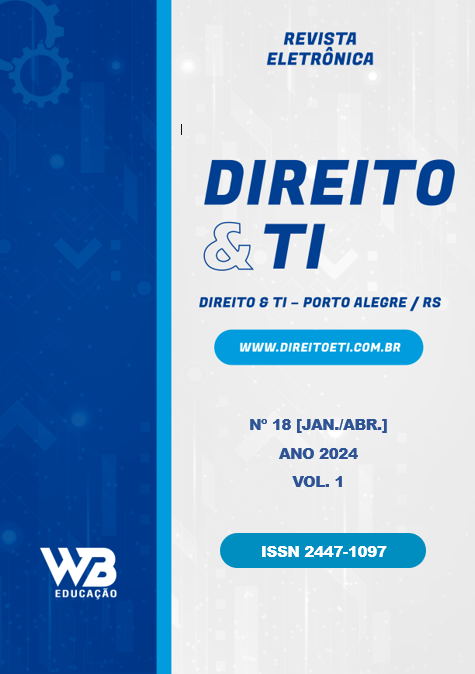CRIPTOATIVOS E PREVENÇÃO À LAVAGEM DE DINHEIRO:
GOVERNANÇA MULTISETORIAL COMO INSTRUMENTO DE COMPATIBILIZAÇÃO DE NORMAS
DOI:
https://doi.org/10.63451/ti.v1i18.125Palabras clave:
criptoativos, governança multisetorial, lavagem de dinheiro, política AMLResumen
Although the cryptocurrencies were created with the aim of bringing benefits to the financial system, they brought with them an increased risk of money laundering. This article aims to demonstrate multisectoral governance as an instrument for the compatibility of norms applicable to the construction of an AML Policy in virtual asset service providers. It is especially justified by the constant increase in the use of cryptocurrencies and the level of sophistication of criminal practices involving these assets, as well as the mandatory development of an AML Policy in compliance with the applicable set of regulations and adapted to the crypto ecosystem. The adopted methodology was bibliographical and documentary research based on the hypothetical-deductive method. It concludes that the adoption of multisectoral governance tools is a good strategy to make the anti-money laundering set of rules compatible, as it is a way of aligning measures before and during the regulatory process and for maximizing the acceptability of regulation and, therefore, its effectiveness.
Descargas
Citas
BOTTINO, Thiago; TELLES, Chrstiana Mariani da Silva. Lavagem de dinheiro, bitcoin e regulação. In: Revista Brasileira de Ciências Criminais, São Paulo: Ed. RT, vol. 148, ano 26, p. 131-176, outubro, 2018.
BRASIL. Congresso Nacional. Decreto nº 5.015, de 12 de março de 2004. Promulga a Convenção das Nações Unidas contra o Crime Organizado Transnacional. Diário Oficial da União, 15 de março de 2004, Brasília DF.
BRASIL. Lei nº 9.613, de 3 de março de 1998. Dispõe sobre os crimes de "lavagem" ou ocultação de bens, direitos e valores; a prevenção da utilização do sistema financeiro para os ilícitos previstos nesta Lei; cria o Conselho de Controle de Atividades Financeiras - COAF, e dá outras providências. Diário Oficial da União, 4 de março de 1998, Brasília DF.
BRASIL. Lei nº 14.478, de 21 de dezembro de 2022. Dispõe sobre diretrizes a serem observadas na prestação de serviços de ativos virtuais e na regulamentação das prestadoras de serviços de ativos virtuais; altera o Decreto-Lei nº 2.848, de 7 de dezembro de 1940 (Código Penal), para prever o crime de fraude com a utilização de ativos virtuais, valores mobiliários ou ativos financeiros; e altera a Lei nº 7.492, de 16 de junho de 1986, que define crimes contra o sistema financeiro nacional, e a Lei nº 9.613, de 3 de março de 1998, que dispõe sobre lavagem de dinheiro, para incluir as prestadoras de serviços de ativos virtuais no rol de suas disposições. Diário Oficial da União, 22 de dezembro de 2022, Brasília DF.
CHAINALYSIS. The 2023 Crypto Crime Report: Everything you need to know about cryptocurrency-based crime. February, 2023. Disponível em: https://go.chainalysis.com/rs/503-FAP-074/images/Crypto_Crime_Report_2023.pdf. Acesso em: 14 mar.2023.
GAFI. FATF. Fatf Recommendations: Guidance virtual asserts, 2021. Disponível em: https://www.fatf-gafi.org/en/publications/Fatfrecommendations/Guidance-rba-virtual-assets-2021.html. Acesso em: 06 mar. 2023.
GAFI. FATF. High risk and other monitored jurisdictions 2022: Increased Monitoring, 2022. https://www.fatf-gafi.org/en/publications/High-risk-and-other-monitored-jurisdictions/Increased-monitoring-october-2022.html/. Acesso em: 06 mar. 2023.
GAFI. FATF. High risk and other monitored jurisdictions 2022: Call for action, 2022. https://www.fatf-gafi.org/en/publications/High-risk-and-other-monitored-jurisdictions/Call-for-action-october-2022.html/. Acesso em: 06 mar. 2023.
GAFI. FATF. Reports G20, 2018. Disponível em: https://www.fatf-gafi.org/media/fatf/documents/reports/FATF-Report-G20-FM-CBG-July-2018.pdf. Acesso em: 11 mar. 2023.
GILCHRIST, Simon; MOJON, Benoit. Credit risk in the euro area. In: The Economic Journal, vol. 128, p. 118–158, 2018.
GRUPENMACHER, Giovana Treiger. As plataformas de negociação de criptoativos: uma análise comparativa com as atividades das corretoras e da Bolsa sob a perspectiva da proteção do investidor e da prevenção à lavagem de dinheiro, 2019. Dissertação (Mestrado em Direito e Desenvolvimento). Escola de Direito de São Paulo, Fundação Getúlio Vargas, São Paulo, 2019. Disponível em: https://bibliotecadigital.fgv.br/dspace/handle/10438/27595. Acesso em: 16 fev. 2023.
GRZYWOTZ, Johanna. Virtuelle Kryptowährungen und Geldwäsche. Berlin: Duncker & Humblot, 2019.
TAKANASHI, Yuta; MATSUO, Shin’ichiro; BURGER, Eric; SULLIVAN, Clare; MILLER, James; SATO, Hirotoshi. Call for Multi-Stakeholder Communication to Establish a Governance Mechanism for the Emerging Blockchain-Based Financial Ecosystem. In: Stanford Journal of Blockchain Law & Policy, vol. 3, n. 2, 2020. Disponível em: https://stanford-jblp.pubpub.org/pub/multistakeholder-comm-governance2/release/1. Acesso em: 05 jan. 2023.
UNIÃO EUROPEIA, Europe Comissions, Directorate-General for Financial Stability, Financial Services and Capital Markets Union. Training for lawyers on anti-money laundering (AML) and counter terrorist financing (CTF) rules at EU level – Trainers’ manual and users’ manual. Fev. 2022. Disponível em https://finance.ec.europa.eu/publications/training-lawyers-anti-money-laundering-aml-and-counter-terrorist-financing-ctf-rules-eu-level_en. Acesso em: 18 mar. 2023.





